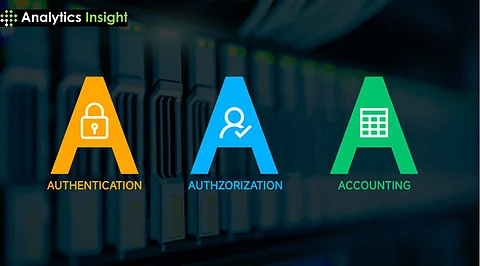

Authentication, authorization, and accounting (AAA) is a security framework that controls access to computer resources, enforces policies, and audits usage. AAA and its combined processes play a major role in network management and cybersecurity by screening users and keeping track of their activity while they are connected.
Authentication: Authentication verifies a user’s identity through login credentials, like a username and password, which are checked against stored data. This process confirms who the user is. Common methods include knowledge-based (password), possession-based (USB key), and biometric (fingerprint) authentication.
Authorization: Authorization determines the access levels granted to a user after authentication. It defines what resources a user can access within a system, which administrators can adjust. For instance, an IT team member may lack permission to change network passwords, but a network administrator can grant them that access.
Accounting: Accounting monitors user activity on a network, tracking login duration, data use, IP addresses, and accessed resources. It’s useful for analyzing user behavior, auditing, and billing. For example, hourly usage data can be used to charge users based on their time spent on the network.
The AAA framework is vital in network security as it controls access, monitors user actions, and helps detect potential security risks. It prevents unauthorized access and allows administrators to track user activity for enhanced oversight. AAA has two main applications: network access, which grants or blocks access based on user credentials, and device administration, which controls access to specific network devices and sessions rather than the network itself. By managing both user and device permissions, AAA strengthens network security and provides crucial intelligence on user behaviour.
RADIUS: RADIUS is a client/server protocol that handles authentication and authorization for remote network users. It encrypts AAA data, enhancing security, and operates in three phases: a user request, a NAS request to the RADIUS server, and a server response to grant, deny, or challenge access.
Diameter: Diameter is an advanced version of RADIUS, optimized for LTE and multimedia networks, specifically designed for telecommunications.
TACACS+: TACACS+ is a protocol similar to RADIUS but separates authentication and authorization processes, allowing finer command control. It also encrypts AAA packets, enhancing data security.
AAA drawbacks include limited encryption strength in some protocols like RADIUS, which may not meet advanced security needs. Implementation can be complex and costly, with significant resource requirements. Scalability issues may arise in large networks, as AAA systems may struggle to efficiently manage high user volumes. Additionally, AAA relies on constant updates and maintenance to ensure effectiveness, and it may lack granular access control options, leading to potential security gaps if configurations are not carefully managed.
Authentication verifies the identity of a user or device, typically through a combination of credentials like usernames, passwords, or digital certificates. It ensures that only known users gain access to network resources.
RADIUS primarily handles authentication and authorization together and is often used for network access. TACACS+ separates authentication, authorization, and accounting functions, making it suitable for environments needing more granular control over user permissions.
AAA provides a layered approach to network security by verifying user identity, controlling access to resources based on roles, and tracking activities for accountability. It reduces unauthorized access, and data misuse, and enhances monitoring for compliance.
AAA’s accounting feature maintains detailed logs of user activities, which helps organizations meet compliance standards like PCI-DSS, HIPAA, and GDPR. These logs serve as evidence for audits and help ensure policy adherence.
Challenges include managing complex permissions for various users, ensuring seamless integration with existing network infrastructure, maintaining scalability for large user bases, and balancing security with user convenience. Additionally, improper configuration can lead to unauthorized access or lockouts.
